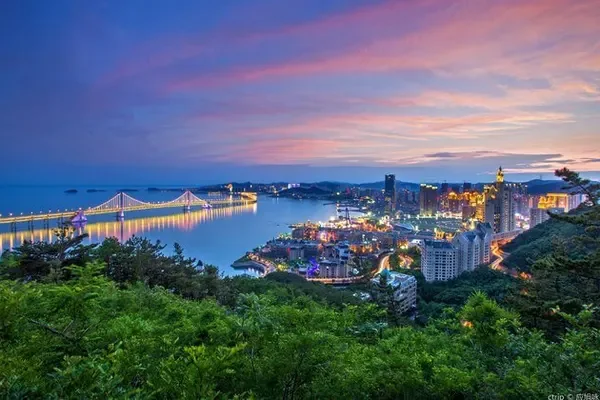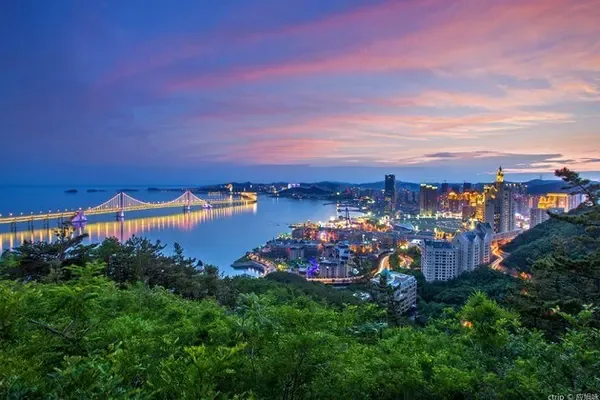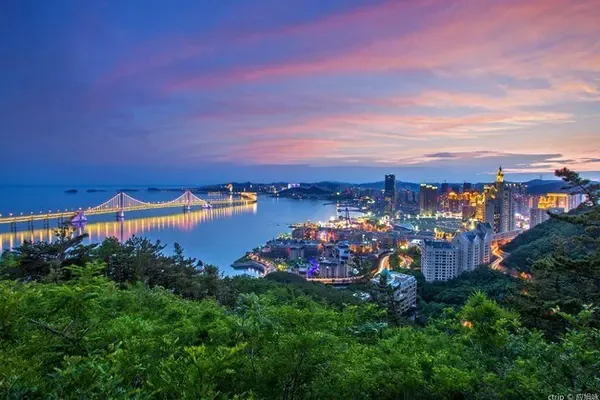Living in the city for a long time, do you have an urge to rush out and release? Experience rural life, taste farm food, especially in the autumn of harvest, pick the fruit by yourself, the feeling is definitely different from the one you bought. Perhaps this is the reason for the rapid rise of rural tourism in recent years. In Beipiao, Liaoning, we have newly discovered a good place for rural tourism. It not only has delicious food and beautiful scenery, but also has a long history and unique local culture. Especially the special jujube here is very sweet. The two-day itinerary is full and rich. And wonderful.


Along the Daling River, the original ecological countryside
Shangyuan Town is located near the Baishi Reservoir in Beipiao, Chaoyang, Liaoning, less than an hour's drive from Beipiao High-speed Railway Station. The town is characterized by Mongolian customs, fishing village culture, fossil culture, jujube culture, red culture, and poetry culture, making it a special tourist destination for rural vacation and leisure. I came to the Daling River in the early morning. After a heavy rain, the flood just receded, and a layer of light mist rose from the river surface, covering the distant mountains and trees, adding a bit of hazy atmosphere to the picture. Such green mountains and green waters are especially rare in western Liaoning, where there has been nine droughts for ten years, and Shangyuan Town is located in this ecologically beautiful environment.


Eating in Shangyuan, Baishi Fishing Village Whole Fish Feast
It is said that food is the most important thing for the people, and the journey in Shangyuan Town started with a whole fish feast, which will give us "foodies" a real treat. Fresh fish and shrimp from Baishi Reservoir and local farm dishes are used as ingredients, fish head, fish tail, fish skin, fish maw, stewed fish, grilled fish, fried fish scales... The method is unique, one fish eats eight, and tastes authentic western Liaoning specialties. Happened at the first meal.



Baishi Reservoir is located on the main stream of Daling River in Liuhuangtun, Goukouzi Village, Shangyuan Town. It is the third largest reservoir in Liaoning and the largest reservoir in western Liaoning. Relying on the mountains to eat the mountains, relying on the water to eat water, relying on rich aquatic resources, combined with the long history, profound culture and unique folk customs here, Liuhuangtun has built the first fishing feast village in western Liaoning---Baishi Fishing Village. Walking into the village, there are fish banquet restaurants one after another. Those who come to Baishi Reservoir for tourism, those who take pictures, and those who pass by are all attracted here to taste the river fish, which is affordable and delicious.



Shangyuan Town has a long history. In the Northern Song Dynasty, it was Shengji County, Qianzhou Prefecture, and in the Jin Dynasty, it was Qiancheng Town, Xingzhong Prefecture. At the beginning of the Yuan Dynasty, it was Luchuanzhou in Beijing, and later it was Luchuanzhou in Yizhou. In the early Ming Dynasty, it was Zhongtunwei in Yingzhou, Daninglu. In the Qing Dynasty, it was successively subordinate to Zhuosutu League Tumote Right Wing Banner, Tazigou Hall, Three Tower Halls, Chaoyang County, and Chaoyang Mansion. In this hot land, the first party branch in rural Liaoning was born, the seeds of revolution were planted, and many revolutionaries emerged, writing epic heroic stories. In Chaoyang Temple Village, the Memorial Hall of the First Party Branch of Chaoyang records that period of history.



Educated youth tribe, memories of youth
In Shangyuan Town, Beipiao, we walked into the educated youth tribe to feel the memories of youth and years of the parents' generation. Walking into a very ordinary one-story house, it has a typical local rural residential layout, a long exhibition hall, and the photos on the wall immediately attracted my attention. Although the characters in the photos have typical characteristics of the times, although I don't know who they are , pulling the audience into that red era.



Not only photos, but the labor tools and daily necessities displayed in the exhibition hall also show us the living conditions of the educated youth. For me who was born in the 1980s, I only knew these things from the stories of my elders, without intuitive feelings and personal experience. Experience, for the parents who have experienced that time, seeing these scenes can even evoke memories of the past, recall the youthful years of that year, and miss that unforgettable time.



Today's educated youth tribe has become a popular attraction for nostalgic experience, especially people born in the 1950s are most interested in these, because it can arouse their sympathy, turn up the stories in their hearts, awaken the memories of youth, full of With the taste of the years.



The Educated Youth Tribe is not only a place for nostalgic memories, but also full of strong local flavor. The houses and courtyards here are typical of local farmhouses. Especially when people from the city come to the Educated Youth Tribe, everything they see is new. Going down the steps, there is a viewing platform where you can watch the Daling River flow quietly, how much time it took away, and how much joy it brought.



The signature specialty, Shangyuan jujube is not only sweet, but also has a story behind it
Good mountains and good waters must have good products. Chaoyang jujube has always been famous in the Northeast, and Jinsiwang jujube produced in Shangyuan Town is the representative of the highest quality of Chaoyang jujube. Jinsiwang jujube not only tastes particularly sweet, but there is a story behind it. In order to understand the origin of Jinsiwang jujube, we came to Baoyingjie Jinsiwang jujube memorial hall.


The memorial hall is located on the hillside, which used to be the old house of Bao Yingjie's family. It was this model worker who cultivated Jinsiwang jujube and led the villagers on the road to wealth. Baoyingjie is a Mongolian, belonging to the Boerzhijin family. According to the family tree, he is the 33rd grandson of Genghis Khan. The spring breeze of reform and opening up in the 1980s blew to the land of western Liaoning. Bao Yingjie, who liked to study hard, became a fruit technician. Because the apple orchard in the Madaigou Brigade in charge had a bumper harvest year after year and outstanding results, he was awarded the honorable title of a provincial model worker.



Later, Bao Yingjie contracted the orchard on the mountain. After careful management, the benefits were considerable. He became the first ten thousand household in the town, a leader in getting rich, and was elected as a representative of the Chaoyang City People's Congress. While planting apple orchards, Bao Yingjie was prepared for danger in times of peace , began to study the transformation of other fruits, but has not been successful. Until the 1990s, when he had a chance to go out, he found a few particularly sweet jujubes, so he brought them back and grafted them on local jujube trees.



Taking advantage of the good adaptability of the mountain jujube tree in frost resistance, cold resistance and disease resistance, the quality has been improved after grafting. The resulting jujube has thin skin, thick flesh, small core, high sugar content, sweet and crisp taste, full appearance and bright color. , so Baoyingjie gave this jujube variety a nice name called "Jinsiwang jujube". In 1998, Jinsiwang jujube was born. Because of its outstanding quality, it won the Chaoyang Gold Award that year and became the most delicious jujube in Chaoyang area.



Jinsiwang jujubes were welcomed as soon as they came into the market, and the supply was in short supply. Bao Yingjie planted more than 40,000 jujube trees in his orchard. Bao Yingjie, who got rich first, promoted Jinsiwang jujube in the whole town, provided technical guidance to the villagers for free, provided scions, and donated more than 300,000 yuan to public welfare. For the jujube business, Bao Yingjie devoted his whole life to the jujube cause, and died young due to overwork. He bred high-quality jujube varieties for the villagers and opened up a new way to get rich through hard work.



Today, Shangyuan Town has an area of more than 20,000 mu of jujube trees, more than 300 households and more than 5,000 people are engaged in the jujube business. More than 30 picking gardens have been established in the town, with an annual output of more than 3 million jin of fresh dates and a total output value of more than 2,000. ten thousand yuan. Shangyuan Town has become a veritable high-quality jujube base. Walking into the jujube orchard on the mountain, the jujubes have begun to be ripe for picking. The fruits of the trees are delightful to look at, and the sweetness of eating is full of joy of harvest.



In order to better promote Jinsiwang jujube, Shangyuan Town has set up a tourism festival with the help of the jujube picking season in recent years, pushing out the jujube and inviting tourists in. Combining reservoirs, fishing villages, ethnic customs, Chaoyang First Party Branch Memorial Hall, Bird Fossil Nature Reserve, ancient ferry, rock paintings and other natural and cultural resources and historical relics, as well as national intangible cultural projects - folk story base, to create a red small The five distinctive brands of the town, Jinsi Town, Fossil Town, Fishing Town, and Fashion Town have become a new tourist destination in western Liaoning.


The birthplace of flowers blooming and birds flying, once shocked the world
In Sihetun, Chaomidian Village, Shangyuan Town, there is the only bird fossil nature reserve in China, which is a sacred place for paleontological researchers all over the world. The discovery of Sinosauropteryx in 1996 and the later discovery of the sage Confucius fossils overturned the claim that the ancestor of birds was Archeopteryx germany. The discovery of ancient fruit fossils in Liaoning represents the oldest angiosperm in the world, and has pushed the previous discovery time forward for more than two thousand years. Therefore, it is known as the place where the first bird flew and the first flower bloomed. place.



Fossils are very common in Shangyuan Township. In the past, many villagers used stone slabs with fossils to build houses and pigpens. They just thought the patterns on them were pretty. They did not know the value of fossils until more than 20 years ago. The fossils here contain animals and plants that are second to none in terms of variety and quantity, and it is a world-class fossil treasure house.



The villagers can write poems, the village poetry competition, and the cultured Shangyuan Village
Leaving our residence, we came to Shangyuan Village, the last stop of this itinerary. Shangyuan has a long history. The ancestors of Shangyuan have multiplied and thrived on this land since the Xiajiadian Lower Culture Period. In the Qing Dynasty, the Mongolian nobles built the upper and lower courtyards of Chaoyang Temple, commonly known as the Upper Garden among the people. For thousands of years, traditional crafts, customs and folk stories have been passed down here, making Shangyuan a cultural "sacred place". Today, in Shangyuan Village, we can see the continuity of culture.



Walking into the entrance of the village, the first thing you see is a stone engraved with the words "Cultural Prosperity Village". This is a cultured village. According to the local people, many people in the village can write poems. Every year, the village holds a poetry competition. Everyone presents their works to exchange ideas. This atmosphere has lasted for a long time in the village.



In order to further bring out the characteristics of the cultural village, a cultural wall of more than 1,000 meters was built in the village, and poems were written on the wall, which is divided into four sections: historical stories, poetry, intangible cultural heritage, and singing and dancing. We walked and read all the way, and the lines were full of careful observation and love for life, showing the cultural history of Shangyuan Town and full of cultural confidence.



Walking in the village, we saw that the roads were clean and tidy, and there were garbage bins in front of every house, and garbage was sorted. There are not only green trees on the side of the road, but also flowers are planted, and the yards of the villagers' homes are also tidy. The appearance of the village reflects the degree of civilization. This village is indeed extraordinary.



The two-day itinerary ended quickly, and it seemed that there was still more to say. The trip to the park in Beipiao made us feel the rich resources and products, the unique folk customs and the enthusiasm of the local people. The scenery here is fresh and natural, the history here is profound and profound, the cultural atmosphere here is rich, and the food here is sweet and mellow. . Encounter with the beautiful countryside, meeting is beautiful.



